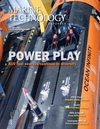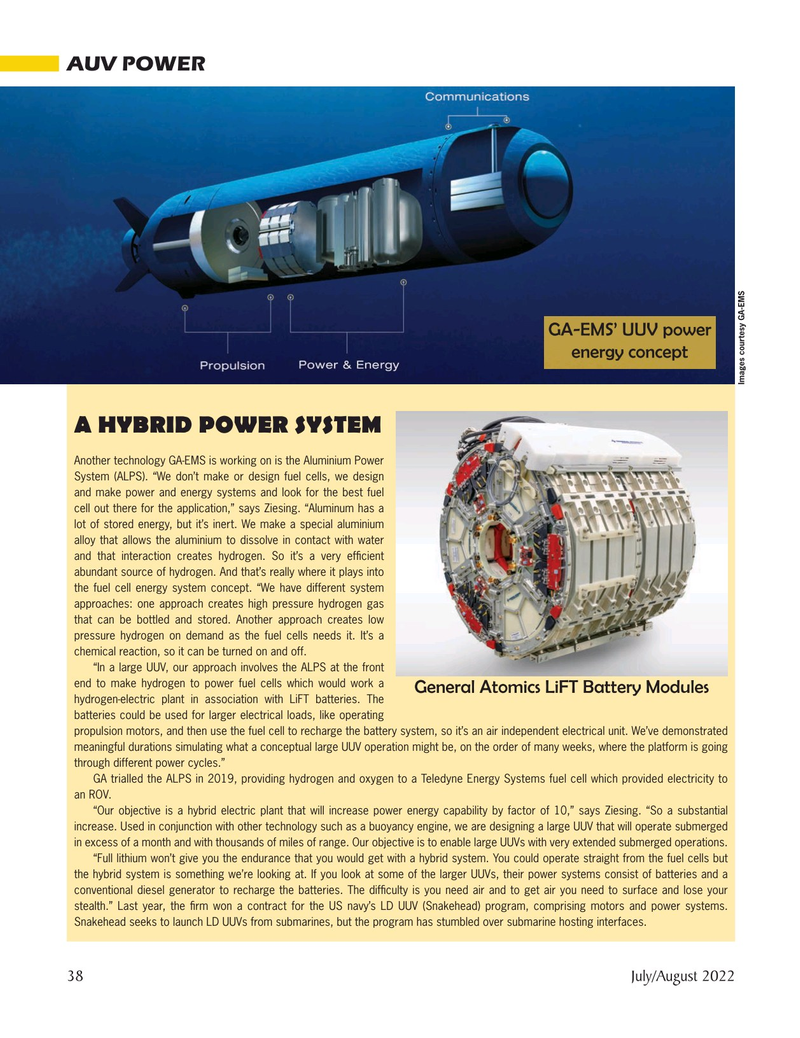
Page 38: of Marine Technology Magazine (July 2022)
Read this page in Pdf, Flash or Html5 edition of July 2022 Marine Technology Magazine
AUV POWER
GA-EMS’ UUV power energy concept
Images courtesy GA-EMS
A HYBRID POWER SYSTEM
Another technology GA-EMS is working on is the Aluminium Power
System (ALPS). “We don’t make or design fuel cells, we design and make power and energy systems and look for the best fuel cell out there for the application,” says Ziesing. “Aluminum has a lot of stored energy, but it’s inert. We make a special aluminium alloy that allows the aluminium to dissolve in contact with water and that interaction creates hydrogen. So it’s a very ef? cient abundant source of hydrogen. And that’s really where it plays into the fuel cell energy system concept. “We have different system approaches: one approach creates high pressure hydrogen gas that can be bottled and stored. Another approach creates low pressure hydrogen on demand as the fuel cells needs it. It’s a chemical reaction, so it can be turned on and off.
“In a large UUV, our approach involves the ALPS at the front end to make hydrogen to power fuel cells which would work a
General Atomics LiFT Battery Modules hydrogen-electric plant in association with LiFT batteries. The batteries could be used for larger electrical loads, like operating propulsion motors, and then use the fuel cell to recharge the battery system, so it’s an air independent electrical unit. We’ve demonstrated meaningful durations simulating what a conceptual large UUV operation might be, on the order of many weeks, where the platform is going through different power cycles.”
GA trialled the ALPS in 2019, providing hydrogen and oxygen to a Teledyne Energy Systems fuel cell which provided electricity to an ROV. “Our objective is a hybrid electric plant that will increase power energy capability by factor of 10,” says Ziesing. “So a substantial increase. Used in conjunction with other technology such as a buoyancy engine, we are designing a large UUV that will operate submerged in excess of a month and with thousands of miles of range. Our objective is to enable large UUVs with very extended submerged operations. “Full lithium won’t give you the endurance that you would get with a hybrid system. You could operate straight from the fuel cells but the hybrid system is something we’re looking at. If you look at some of the larger UUVs, their power systems consist of batteries and a conventional diesel generator to recharge the batteries. The dif? culty is you need air and to get air you need to surface and lose your stealth.” Last year, the ? rm won a contract for the US navy’s LD UUV (Snakehead) program, comprising motors and power systems.
Snakehead seeks to launch LD UUVs from submarines, but the program has stumbled over submarine hosting interfaces.
38 July/August 2022
MTR #5 (34-49).indd 38 6/30/2022 1:25:14 PM

 37
37

 39
39
